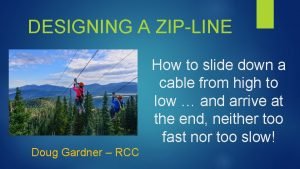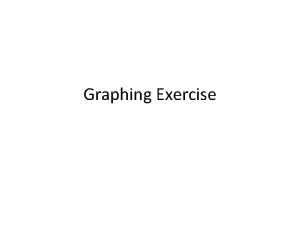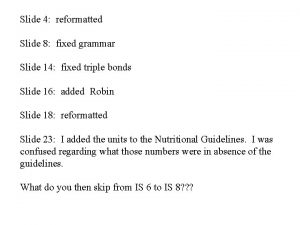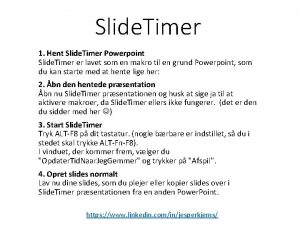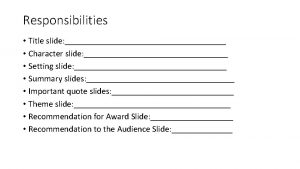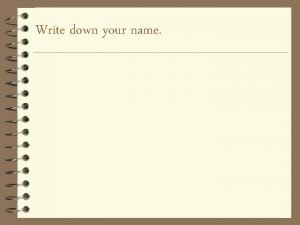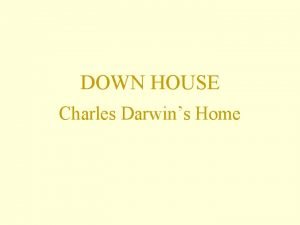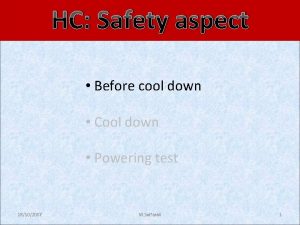DESIGNING A ZIPLINE How to slide down a
























- Slides: 24

DESIGNING A ZIP-LINE How to slide down a cable from high to low … and arrive at the end, neither too fast nor too slow! Doug Gardner – RCC

“If I had to design a mechanism for the express purpose of destroying a child’s natural curiosity … I couldn’t possibly do as good a job as is currently being done … in contemporary mathematics education. (pg. 20) “You don’t start with definitions, you start with problems … nobody ever thought of irrational numbers until Pythagoras attempted to find the diagonal of a square. ”(pg. 79)

I HOPE SOMEONE THOUGHT THIS THROUGH Not sure about this LZ

1960 Essay: The Unreasonable Effectiveness of Mathematics in the Natural Sciences

What form does the shape of the cable take? f

The question has a storied past … Galileo maintained the curve was a parabola … which was later disproven by Jungius in 1669. Jakob Bernoulli proposed the challenge to obtain an equation for this curve which was ultimately met by Leibniz, Huygens and Johann Bernoulli in 1691. It was Huygens who coined the name CATENARY for this curve … which is appropriately derived from the Latin word for “chain” … or perhaps inappropriately if you don’t speak Latin.

What does the constant value ‘a’ represent on the curve? The constant represents the y-intercept … or more importantly for our consideration … the curvature of the catenary curve.

THE PROBLEM: Find the catenary equation with the proper curvature so that someone can enjoy the benefits of gravity and slide down with enough sag in the cable to enable them to reach the landing, but at a reasonable speed.

Givens for a particular zip-line design: W = width between the supports H = height between the supports s = arc length of the cable Find a function y(x) to model the curve






Now to see what the Zipline manufacturers have to say about our choices for W, H & S:

Zipline manufacturer recommendations: • The slope (H/W) from start to finish should be 3 – 6% … depending on the friction coefficient of the trolley • A cable should sag approximately 2% of its length (S) as measured from the low point … the sag (y) is measured when the cable is pulled tight from the lower support.


Putting it all together: Suppose we want a zip-line with a horizontal distance of W = 2430 ft If we choose a trolley that will allow a 4% slope then . 04 * 2430 = H ≈ 97 ft. And substituting these values for W, H and S back into (18) and solving yields a value for a ≈ 10096 ft and an unweighted sag ≈ 32. 8 ft.

Note: W = 2430 ft H = 97 ft S ≈ 2438 ft sag ≈ 32. 8 ft When a = 10, 096

let’s test out the Unreasonable Effectiveness of Mathematics in the Natural Sciences https: //www. desmos. com/calculator/flxv 4 jjxe 1 W = 130 cm H = 20 cm S = 148 cm

Doug Gardner – RCC dgardner@roguecc. edu



 Zip line design formula
Zip line design formula Uakron zipline
Uakron zipline Heel toe polka
Heel toe polka Slide method factoring
Slide method factoring A 23 kg child goes down a straight slide
A 23 kg child goes down a straight slide Heriing
Heriing A train pulls into a station and lets off its passengers
A train pulls into a station and lets off its passengers King jesus you're the name
King jesus you're the name I fled him
I fled him Hands on your hips
Hands on your hips There's a place where mercy reigns and never dies
There's a place where mercy reigns and never dies Pushing down on me pushing down on you
Pushing down on me pushing down on you Hrd program
Hrd program Designing learner-centric moocs
Designing learner-centric moocs Patrick baudisch
Patrick baudisch Wedge shaped sales territory
Wedge shaped sales territory First step in designing an experiment
First step in designing an experiment Designing and managing services ppt
Designing and managing services ppt Designing and managing services
Designing and managing services Interface and dialogue design
Interface and dialogue design Accurate data entry
Accurate data entry Design a secure network
Design a secure network Designing embedded systems with pic microcontrollers
Designing embedded systems with pic microcontrollers Designing a customer driven marketing strategy
Designing a customer driven marketing strategy Designing distribution network
Designing distribution network
